|
February 21, 2000
NEWSLINKS
US EDITION
COLUMNISTS
DIARY
SPECIALS
INTERVIEWS
CAPITAL BUZZ
REDIFF POLL
DEAR REDIFF
THE STATES
YEH HAI INDIA!
ELECTION 99
ELECTIONS
ARCHIVES
|
 Varsha Bhosle
Varsha Bhosle
Back to school...
We were in Mizoram last week. Not in the state capital, Aizawl, which has
more cars per person than even Delhi, but in Vairengte, a "village"
bordering the Cachar district of Assam. "Village" because it's nothing but
ten-odd shanties perched on stilts on the drop-side of the road up the hill
to the Counter Insurgency And Jungle Warfare School run by the Indian Army.
Battalions which are inducted into any of the "seven sisters" -- the
north-east states of Arunachal Pradesh, Assam, Manipur, Meghalaya, Mizoram,
Nagaland and Tripura -- are trained here in the special requirements for
countering insurgency in the area. More interestingly, selected officers,
JCOs and NCOs, no matter where their posting, as well as men of the CRPF,
BSF and Assam Rifles, besides "students" from foreign countries, are
enrolled for an extensive course in basic as well as NE-specific CI
operations.
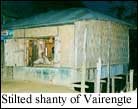 However, a school is just a school -- it ain't quite a story. Unless it has
functioned as the premier and only institution of its kind in the country
for 30 years -- and hardly any reporter has heard of it, let alone visit
it. Then, it becomes a scoop. When we got a whiff of it, our martial ears
tingled; we put out feelers among our khakied friends, who said they had no
clue what we were talking about. Sure that we were being rebuffed, we
became Ophelia, and brightened only after a CIJWS officer exclaimed: "How did you
hear about the school? Hardly anyone in the army itself knows of us!" He
immediately launched into we-are-completely-transparent-nothing-is-classified blah blah, but the
point is, training in CI ops hinges on research, analysis, strategy and tactics.
And therein lies the sensitive nature of this lean and mean institution.
However, a school is just a school -- it ain't quite a story. Unless it has
functioned as the premier and only institution of its kind in the country
for 30 years -- and hardly any reporter has heard of it, let alone visit
it. Then, it becomes a scoop. When we got a whiff of it, our martial ears
tingled; we put out feelers among our khakied friends, who said they had no
clue what we were talking about. Sure that we were being rebuffed, we
became Ophelia, and brightened only after a CIJWS officer exclaimed: "How did you
hear about the school? Hardly anyone in the army itself knows of us!" He
immediately launched into we-are-completely-transparent-nothing-is-classified blah blah, but the
point is, training in CI ops hinges on research, analysis, strategy and tactics.
And therein lies the sensitive nature of this lean and mean institution.
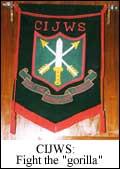 In 1967, Field Marshal SHFJ Manikshaw, then GOC Eastern Command, realised
that the heavy casualties suffered by the security forces at the hands of
insurgents in Nagaland and Mizoram were due to the lack of understanding --
climatic, geographical and psychological -- of the region and its peoples.
Thus, on 1 May, 1970, the CIJWS was mid-wifed by Brig Mathew Thomas in
Vairengte. The next year, when Mrs G and Sam were, hehehe, cleaving
Pakistan, the school was reorganised as HQ Kilo Force -- its personnel
actively took part in Op Jackpot -- and helped East Pakistan flower into
Bangladesh. The then commandant (principal, in civilian terms), Brig Anand
Sarup, was awarded the Maha Veer Chakra for his valour in the BD operation.
But in 1972, the school reverted to its basic role of education. Bunkum.
Today, instructors and trainees undertake CI ops and low intensity combat
as and when required. Only, they call it "practicals." This makes CIJWS a
"semi-field" area: not at the battle front, but not away, either.
In 1967, Field Marshal SHFJ Manikshaw, then GOC Eastern Command, realised
that the heavy casualties suffered by the security forces at the hands of
insurgents in Nagaland and Mizoram were due to the lack of understanding --
climatic, geographical and psychological -- of the region and its peoples.
Thus, on 1 May, 1970, the CIJWS was mid-wifed by Brig Mathew Thomas in
Vairengte. The next year, when Mrs G and Sam were, hehehe, cleaving
Pakistan, the school was reorganised as HQ Kilo Force -- its personnel
actively took part in Op Jackpot -- and helped East Pakistan flower into
Bangladesh. The then commandant (principal, in civilian terms), Brig Anand
Sarup, was awarded the Maha Veer Chakra for his valour in the BD operation.
But in 1972, the school reverted to its basic role of education. Bunkum.
Today, instructors and trainees undertake CI ops and low intensity combat
as and when required. Only, they call it "practicals." This makes CIJWS a
"semi-field" area: not at the battle front, but not away, either.
Frankly, we were torn between giving you hard information about the school
and being our usual giddy-headed self. We finally opted for the latter
because any dolt can compile and relay data, and we are the Monet of
painting impressions... Readers who squinted through our Y2K-on-LC series
will be pleased to find that this article is be-Jewella-ed. The sainted
editor believes we wanted to spare you the pain of deciphering our
photographs; we merely needed someone to hold our sceptre when we doodled.
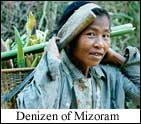 So where to begin? At the tarmac of Kumbhigram airport, where we were
informed that neither had we landed in Silchar, nor was Silchar in
Mizoram...? You see, like 95 per cent of those not of the NE, our knowledge about
the Mongoloid states of India is just a little above zero. Turned out,
Silchar is in Assam; Kumbhigram, also in Assam, is a good dusty
hour-and-half away; and the NE does not mean spear-toting, er... slope-eyed
people in glorious tribal shawls. Therefore, the first lesson we learnt
from this adventure is: It's the negligence of the rest of India that has
augmented, if not created, the unrest in the NE. Everything you know or
want to know about insurgency is that of Kashmir's. But the trouble brewing
incessantly in the NE is somehow not of much interest to us. We quickly
turn the page after scanning headers spelling death datelined Dimapur. It's all
so geographically far away from Chandigarh, Cochin or Chennai. Question is,
why's it emotionally distant, too...?
So where to begin? At the tarmac of Kumbhigram airport, where we were
informed that neither had we landed in Silchar, nor was Silchar in
Mizoram...? You see, like 95 per cent of those not of the NE, our knowledge about
the Mongoloid states of India is just a little above zero. Turned out,
Silchar is in Assam; Kumbhigram, also in Assam, is a good dusty
hour-and-half away; and the NE does not mean spear-toting, er... slope-eyed
people in glorious tribal shawls. Therefore, the first lesson we learnt
from this adventure is: It's the negligence of the rest of India that has
augmented, if not created, the unrest in the NE. Everything you know or
want to know about insurgency is that of Kashmir's. But the trouble brewing
incessantly in the NE is somehow not of much interest to us. We quickly
turn the page after scanning headers spelling death datelined Dimapur. It's all
so geographically far away from Chandigarh, Cochin or Chennai. Question is,
why's it emotionally distant, too...?
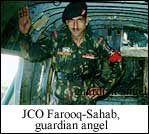 We'll get to that by and by. First, we have to tell you about our latest
guardian angel, JCO Farooq Ahmed, a Kashmiri from Poonch, who received a
gallantry award on January 26 for dispatching three ULFA terrorists during
a midnight encounter in Nalbari. The story is thrillingly gory but, sorry, we
can't tell you because Chindu & Co will pounce on us. Point is, the men
selected for CIJWS are those who fulfill certain qualitative
requirements...
We'll get to that by and by. First, we have to tell you about our latest
guardian angel, JCO Farooq Ahmed, a Kashmiri from Poonch, who received a
gallantry award on January 26 for dispatching three ULFA terrorists during
a midnight encounter in Nalbari. The story is thrillingly gory but, sorry, we
can't tell you because Chindu & Co will pounce on us. Point is, the men
selected for CIJWS are those who fulfill certain qualitative
requirements...
With that, we entered the grand portal of the school, motto: Fight The
Guerrilla Like A Guerilla (faithfully pronounced "gorilla" by all). We
dumped our bag in our room (conveniently close to the officers' mess), in a
setting so arboreal that we forgot our assignment. But not for long: at 11
am sharp we were to report for a briefing to the commandant, Brig HS Nahal
of the Jat Regiment. Briefing?? Moi...?
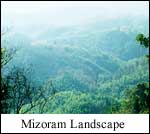 All of Mizoram is uniformly hilly; meaning, inclines everywhere; meaning,
steep steps to navigate between one cabin and another. Meaning, not a
single room did we enter without panting and sweating. And so we gasped to Col
Sharma (officer General Staff, a dear man known throughout as GS), to be
vetted before meeting the commandant. Oooh and what a specimen of dignity
he turned out to be! We simply stared at this gracefully graying Sardar
while we got a briefing on... GEOGRAPHY. Honest! With a map and laser
indicator! We now know that primary jungles are the untouched ones,
secondary are cut-and-grown, with thicker undergrowth; what alluvial soil
is; what the composition of the terrain of Nagaland is; the climate of
Mizoram (humidity 90 per cent, rains 8 months); the uses of bamboo; the flora,
fauna, etc, etc. Oh gawwd, we were back in school...
All of Mizoram is uniformly hilly; meaning, inclines everywhere; meaning,
steep steps to navigate between one cabin and another. Meaning, not a
single room did we enter without panting and sweating. And so we gasped to Col
Sharma (officer General Staff, a dear man known throughout as GS), to be
vetted before meeting the commandant. Oooh and what a specimen of dignity
he turned out to be! We simply stared at this gracefully graying Sardar
while we got a briefing on... GEOGRAPHY. Honest! With a map and laser
indicator! We now know that primary jungles are the untouched ones,
secondary are cut-and-grown, with thicker undergrowth; what alluvial soil
is; what the composition of the terrain of Nagaland is; the climate of
Mizoram (humidity 90 per cent, rains 8 months); the uses of bamboo; the flora,
fauna, etc, etc. Oh gawwd, we were back in school...
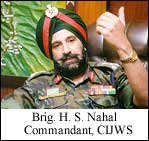 Our eyes were just glazing over, and the brigadier said: "If the soldier
does not know all this, how can he live off the land? There's now a change
in the psyche of the terrorist -- he has become lazy; he prefers to be near
townships. But he always retreats to the jungles, and we must know how to
tackle him in his surroundings. Knowledge of the ground, knowing the lay of
the land, is a force multiplier." Rambo!! We woke up. Perhaps the last time
Indians fought as an army in a jungle was when Sam Manikshaw commanded a
Sikh company in the Burma campaign in 1942. Insurgency and demands for
secession have existed in NE since the late forties. Our friendly
neighbours, China, Bangladesh and Myanmar, added no little fuel to the
fire -- nor did our goodly pinkos. All of which necessitates the CIJWS.
Our eyes were just glazing over, and the brigadier said: "If the soldier
does not know all this, how can he live off the land? There's now a change
in the psyche of the terrorist -- he has become lazy; he prefers to be near
townships. But he always retreats to the jungles, and we must know how to
tackle him in his surroundings. Knowledge of the ground, knowing the lay of
the land, is a force multiplier." Rambo!! We woke up. Perhaps the last time
Indians fought as an army in a jungle was when Sam Manikshaw commanded a
Sikh company in the Burma campaign in 1942. Insurgency and demands for
secession have existed in NE since the late forties. Our friendly
neighbours, China, Bangladesh and Myanmar, added no little fuel to the
fire -- nor did our goodly pinkos. All of which necessitates the CIJWS.
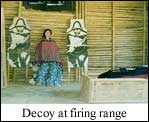 The charter of the school is to act as a nodal agency ("look up the
dictionary," was the curt clarification) for all CI ops in the NE. Courses
include language familiarisation in Nagamese, Tangkhul, Assamese, and
Manipuri dialects; area-specific history, and theatre-specific training.
The school has eleven firing ranges for different scenarios: quick response
shooting, urban shooting and pursuit, ambush, jungle lane shooting, chance
encounter, mobile firing, etc. But, what does jungle warfare entail,
exactly...?
The charter of the school is to act as a nodal agency ("look up the
dictionary," was the curt clarification) for all CI ops in the NE. Courses
include language familiarisation in Nagamese, Tangkhul, Assamese, and
Manipuri dialects; area-specific history, and theatre-specific training.
The school has eleven firing ranges for different scenarios: quick response
shooting, urban shooting and pursuit, ambush, jungle lane shooting, chance
encounter, mobile firing, etc. But, what does jungle warfare entail,
exactly...?
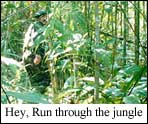 To fight and win in the jungle is tough, both physically and mentally:
Jungle operations test platoons to their limit since communications are
rendered difficult. In 1941, the Japs prepared to capture Singapore with
the help of a booklet titled, Read This Alone and You Can Win the War; it
became the foundation for what's called TTP: tactics, techniques and procedures.
It was, basically, drills and common-sense tips on how to survive in the
jungle by studying its characteristics: Dense vegetation with limited visibility;
heavy cross compartmentation; streams and rivers; heat and humidity; few
roads; numerous tracks. It is in this theatre that students live and train.
They have a time of their life when made to run the Mad Mathew Mile in
minutes flat, and run it again if they can't -- often suckling leeches
during the rains.
To fight and win in the jungle is tough, both physically and mentally:
Jungle operations test platoons to their limit since communications are
rendered difficult. In 1941, the Japs prepared to capture Singapore with
the help of a booklet titled, Read This Alone and You Can Win the War; it
became the foundation for what's called TTP: tactics, techniques and procedures.
It was, basically, drills and common-sense tips on how to survive in the
jungle by studying its characteristics: Dense vegetation with limited visibility;
heavy cross compartmentation; streams and rivers; heat and humidity; few
roads; numerous tracks. It is in this theatre that students live and train.
They have a time of their life when made to run the Mad Mathew Mile in
minutes flat, and run it again if they can't -- often suckling leeches
during the rains.
But were we interested in such huffing and puffing? Not! For no matter how
crucial physical fitness is, we are a cerebral personage... We figured, if
Nana Patekar was allowed to train in Belgaum as a commando for a film role,
we'd be allowed to attend some classes. Our heart was set on Intelligence
Collection, Covert Ops, and IED Awareness. Unfortunately, the thumb rule in
military CI training is: Trust No One (unless it happens to be someone from
Outlook, we suppose). So we made do with shimmying up to certain officers
and wringing out we wanted, and thereby expanded other boundaries of our
personality, too. It's called unconventional int collection.
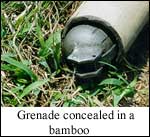 But did GS need to be so cagey...? Ya. For instance, a lecture on the
NSCN(I-M), the most powerful terrorist unit operational in entire NE, would
also include an account of its known weaknesses and how they could be
exploited. If that info leaked to its members, they'd plug the holes. So
yes, it's sticky territory. Similarly, we aren't allowed to even describe
the school's collection of defused IEDs since it could give ideas to
budding murderers. Suffice to say, The Specialist doesn't seem an unrealistic movie
anymore. What with the Internet and hi-tech communications, the nature of
even rural insurgency has become very dynamic; the terrorist's modus
operandi is changing everyday. Explosives may be concealed in hollow
bamboos or may be solar-controlled. The molotov cocktail? We could make it in 10
minutes flat and without visiting a chemist (beware, Dilip!). The task
before the army is indeed an onerous one.
But did GS need to be so cagey...? Ya. For instance, a lecture on the
NSCN(I-M), the most powerful terrorist unit operational in entire NE, would
also include an account of its known weaknesses and how they could be
exploited. If that info leaked to its members, they'd plug the holes. So
yes, it's sticky territory. Similarly, we aren't allowed to even describe
the school's collection of defused IEDs since it could give ideas to
budding murderers. Suffice to say, The Specialist doesn't seem an unrealistic movie
anymore. What with the Internet and hi-tech communications, the nature of
even rural insurgency has become very dynamic; the terrorist's modus
operandi is changing everyday. Explosives may be concealed in hollow
bamboos or may be solar-controlled. The molotov cocktail? We could make it in 10
minutes flat and without visiting a chemist (beware, Dilip!). The task
before the army is indeed an onerous one.
We were pondering this as we climbed the 43rd step towards lunch and, well,
missed the 44th. It was just a 3 feet drop off the concrete, but it was
onto a slope and the momentum rolled us till we hit a thorny bush. Our pride,
too, came up battered blue -- because it was witnessed by the ishgaadi head
of the Courses Wing, Lt Col Harsh K Tiwari of JAK RIF. You see, earlier, it
had been love at first word, and that was even before we learnt that the
colonel was a commando, an NSG Black Cat, and Sena Medal winner: He
had somehow decided that we were a responsible adult -- a novelty for us
-- and trusted us with hair-raising tales, and so of course we fell. From
the steps, too.
But is that all it takes to jive our amour? Rubbish! That night, when we
were merry-making in the bar and being ribbed about civilian paunches, we
retorted, "Big deal, even Harsh has a paunch." And Col Thakur, the gentlest
soldier we've ever met, said, "Tiwari had a cancerous growth in his
stomach. He was operated upon 4 times. But he opted to serve in field area." Our Old
Monk gauge hit zero...
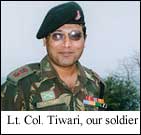 Next morning, we collared the commando. Reply, all interspersed with
guffaws: "I didn't know I had it! One day I went to donate blood at the
same hospital in which I had my stomach operation, and on the sheet I had to
sign, the stupid doctor wrote 'pancreatic sarcoma.' Mujhe Rajesh Khanna ka
Anand picture yaad aya. Remember that 'lymphosarcoma of the intestines'?
Maine socha, yeh sarcoma kyun likha hai, bhai? Then I found out, they
couldn't diagnose where it was and so hadn't told me. With each surgery,
they found out more... Bas, main ghar baithh-ke bhi kya karta?"
Next morning, we collared the commando. Reply, all interspersed with
guffaws: "I didn't know I had it! One day I went to donate blood at the
same hospital in which I had my stomach operation, and on the sheet I had to
sign, the stupid doctor wrote 'pancreatic sarcoma.' Mujhe Rajesh Khanna ka
Anand picture yaad aya. Remember that 'lymphosarcoma of the intestines'?
Maine socha, yeh sarcoma kyun likha hai, bhai? Then I found out, they
couldn't diagnose where it was and so hadn't told me. With each surgery,
they found out more... Bas, main ghar baithh-ke bhi kya karta?"
Donate blood, too...??? *That* is the profile of the Indian soldier. Our
soldier...
Photographs: Jewella C Miranda
Varsha Bhosle
|